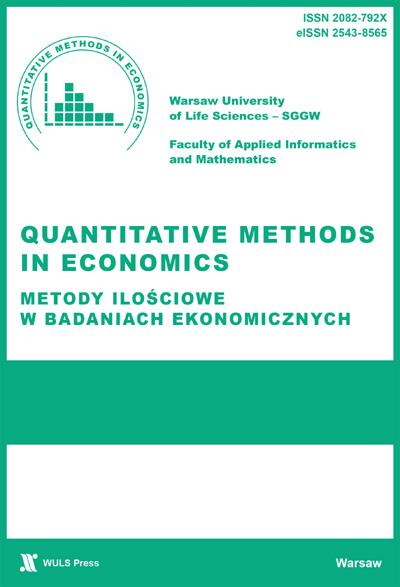Main Article Content
Article Details
Babbie E. (2013) Podstawy badań społecznych. Wydawnictwo Naukowe PWN, Warszawa.
Babbie E. (2019) Badania społeczne w praktyce. Wydawnictwo Naukowe PWN, Warszawa.
Barnett V. (2009) Sample Survey. Principles and Methods. John Wiley and Sons, Hoboken, NJ, USA.
Beigl P., Lebersorger S., Salhofer S. (2010) Modelling Municipal Solid Waste Generation: A Review. Waste Management, 2008, 28(1), 200‐214. (Crossref)
Beretta C., Stoessel F., Baier U., Hellweg S. (2013) Quantifying Food Losses and the Potential for Reduction in Switzerland. Waste Management, 33(3), 764-773. (Crossref)
Bernstad A., la Cour Jansen J. (2012) Review of Comparative LCAs of Food Waste Management Systems – Current Status and Potential Improvements. Waste Management, 32(12), 2439-2455. (Crossref)
Bilska B., Kołożyn-Krajewska D. (red.) (2016) Model ograniczenia strat i marnowania żywności z korzyścią dla społeczeństwa (MOST). Wyd. Naukowe PTTŻ, Kraków.
Braeutigam K.-R., Jörissen J., Priefer C. (2014) The Extent of Food Waste Generation across EU-27: Different Calculation Methods and the Reliability of their Results. Waste Management & Research, 32(8), 683-694. (Crossref)
C(2019)3211final. Decyzja Delegowana Komisji (UE) z dnia 03.05.2019 r. uzupełniająca dyrektywę Parlamentu Europejskiego i Rady 2008/98/WE w odniesieniu do wspólnej metody i minimalnych wymagań jakościowych dla jednolitego pomiaru poziomów odpadów żywności.
Caldeira C., Corrado S., Sala S. (2017) Food Waste Accounting. Methodologies, Challenges and Opportunities. JRC Technical Reports, European Commission, s. 10.
Chybalski F. (2017) O uogólnianiu wyników analiz ilościowych w naukach o zarządzaniu. Zeszyty Naukowe Politechniki Łódzkiej: Organizacja i Zarządzanie, 67, 5-18.
COM(2015) 614 final. Communication from the Commission to the European Parliament, the Council, the European Economic and Social Committee and the Committee of the Regions. Closing the Loop -an EU Action Plan for the Circular Economy.
COM(2018) 29 final. Communication from the Commission to the European Parliament, the Council, the European Economic and Social Committee and the Committee of the Regions on a Monitoring Framework for the Circular Economy.
Corrado S., Ardente F., Sala S., Saouter E. (2017) Modelling of Food Loss within Life Cycle Assessment: From Current Practice Towards a Systematisation. Journal of Cleaner Production, 140(2), 847-859. (Crossref)
Duchin F. (2005) Sustainable Consumption of Food: A Framework for Analyzing Scenarios about Changes in Diets. Journal of Industrial Ecology, 9(1‐2), 99‐114. (Crossref)
Dyrektywa Parlamentu Europejskiego i Rady 2008/98/WE z dnia 19 listopada 2008 roku w sprawie odpadów.
FAO (2011) Global Food Losses and Food Waste – Extent, Causes and Prevention. Rome.
FAO (2014) SAVE FOOD: Global Initiative on Food Loss and Waste Reduction. Definitional framework of food loss. Working Paper, Rome, February 2014.
Food Loss and Waste Accounting and Reporting Standard. (2016) Version 1.1, World Resources Institute.
FUSIONS (2014) Definitional Framework for Food Waste. Full Report. Reducing Food Waste Through Social Innovation.
FUSIONS (2014) Report on Review of (Food) Waste Reporting Methodology and Practice. Reducing Food Waste Through Social Innovation.
FUSIONS (2016) Food Waste Quantification Manual to Monitor Food Waste Amounts and Progression.
Joosten L. A. J., Hekkert M. P., Worrell E., Turkenburg W. C. (1998) STREAMS: a New Method for Analysing Material Flows Through Society. Resources, Conservation and Recycling, 27(3), 249-266. (Crossref)
Karadimas N. V., Loumos V. G. (2008) GIS‐Based Modeling for the Estimation of Municipal Solid Waste Generation and Collection. Waste Management & Research, 26(4), 337‐346. (Crossref)
Kośny M., Peternek P. (2011) Wielkość próby a istotność wnioskowania statystycznego. Didactics of Mathematics, 8(12), 71-80.
Krajewski K., Lipińska M., Wrzosek M., Bilska B., Kołożyn- Krajewska D. (2016) Food Waste - Four Dimensions of Security: Economic, Social, Energy and Environmental. Intercathedra, 32(2), 47-53.
Kwasek M. (red.), Borowski M., Kowalewska M., Obiedzińska A. (2016) Analiza strat i marnotrawstwa żywności na świecie i w Polsce. Z badań nad rolnictwem społecznie zrównoważonym (37), Instytut Ekonomiki Rolnictwa i Gospodarki Żywnościowej, Państwowy Instytut Badawczy, Warszawa.
Langley J., Yoxall A., Heppell G., Rodriguez E. M., Bradbury S., Lewis R., Luxmoore J., Hodzic A., Rowson J. (2010) Food for Thought? – A UK Pilot Study Testing a Methodology for Compositional Domestic Food Waste Analysis. Waste Management & Research, 28(3), 220-227. (Crossref)
Östblom G., Söderman M. L., Sjöström M. (2010) Analysing Future Solid Waste Generation ‐ Soft Linking a Model of Waste Management with a CGE‐Model for Sweden. The National Institute of Economic Research (NIER), Stockholm.
PN-EN ISO 22000:2006 Systemy zarządzania bezpieczeństwem żywności. Wymagania dla każdej organizacji należącej do łańcucha żywnościowego. (2006) PKN, Warszawa.
Preparatory Study on Food Waste across EU27. European Commission, Technical Report - 2010 - 054, BIOIS (2010).
Salhofer S. (2000) Modelling Commercial/Industrial Waste Generation: a Vienna, Austria Case Study. Waste Management & Research, 18(3), 269‐282. (Crossref)
State-of-Play on the Global Food Loss Index to Monitor SDG 12.3. 2017.
Steczkowski J. (1995) Metoda reprezentacyjna w badaniach ekonomiczno-społecznych. Wydawnictwo Naukowe PWN, Warszawa.
Szreder M. (2010) Losowe i nielosowe próby w badaniach statystycznych. Przegląd Statystyczny, 57(4), 168-174.
Ward S. (2018) EIP-AGRI Focus Group. Reducing Food Loss on the Farm: a Holistic Approach, Dublin.
WRAP (2013) Household Food and Drink Waste in the United Kingdom.
WRAP (2017) Food Waste in Primary Production - a Preliminary Study on Strawberries and Lettuce. Prepared by 3Keel LLP and University of Warwick. The Waste and Resources Action Programme.
Downloads
- Karol Krajewski, Mikołaj Niedek, Sylwia Łaba, Krystian Szczepański, Bolesław Borkowski, METHODOLOGICAL BARRIERS OF MONITORING AND RESEARCH OF FOOD LOSSES AND WASTE (FLW) , Metody Ilościowe w Badaniach Ekonomicznych: Tom 20 Nr 1 (2019)

Utwór dostępny jest na licencji Creative Commons Uznanie autorstwa – Użycie niekomercyjne 4.0 Międzynarodowe.
Publikowane artykuły dostępne są na warunkach Open Access na zasadach licencji Creative Commons CC BY-NC – do celów niekomercyjnych udostępnione materiały mogą być kopiowane, drukowane i rozpowszechniane. Autorzy ponoszą opłatę za opublikowanie artykułu.





